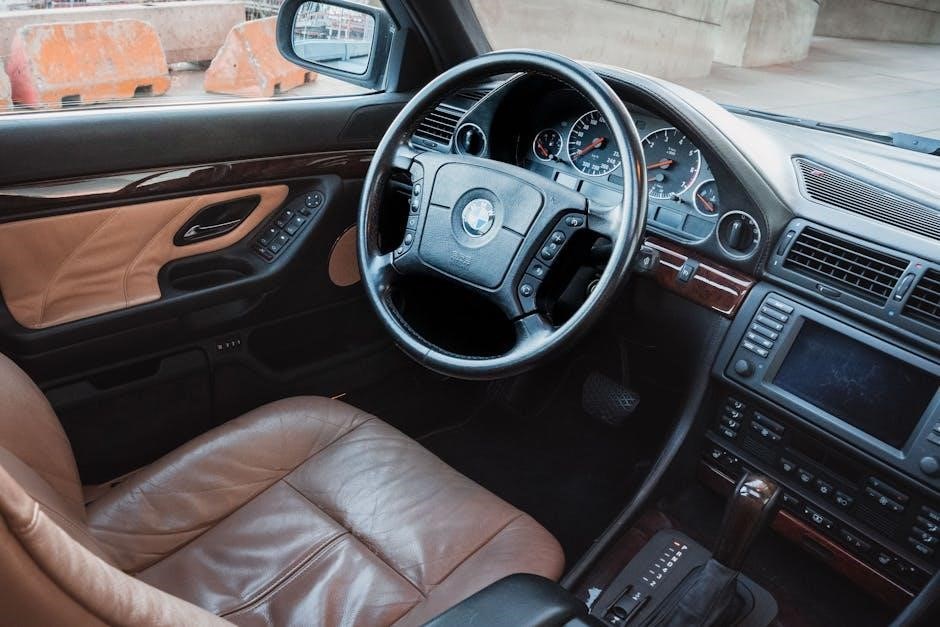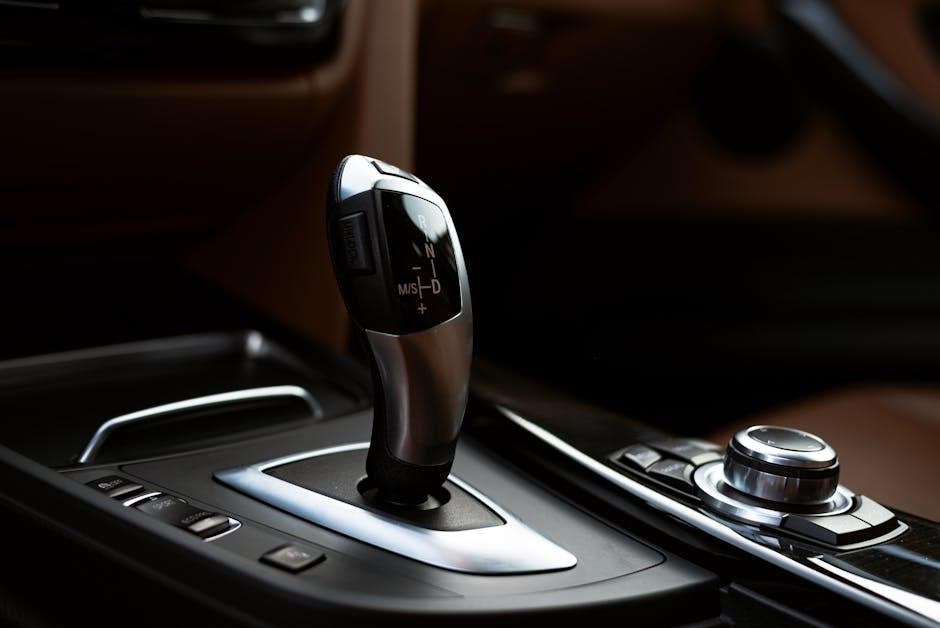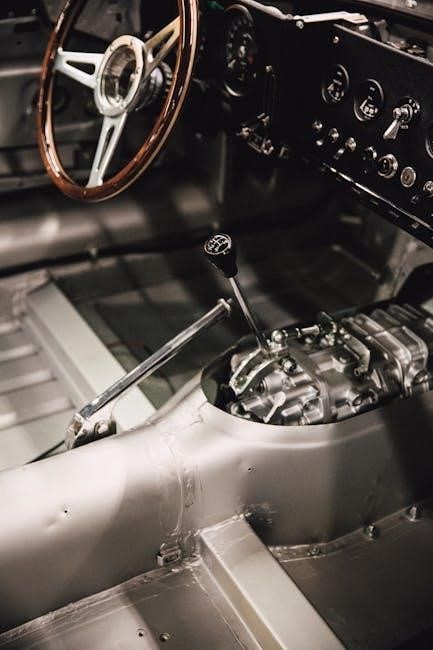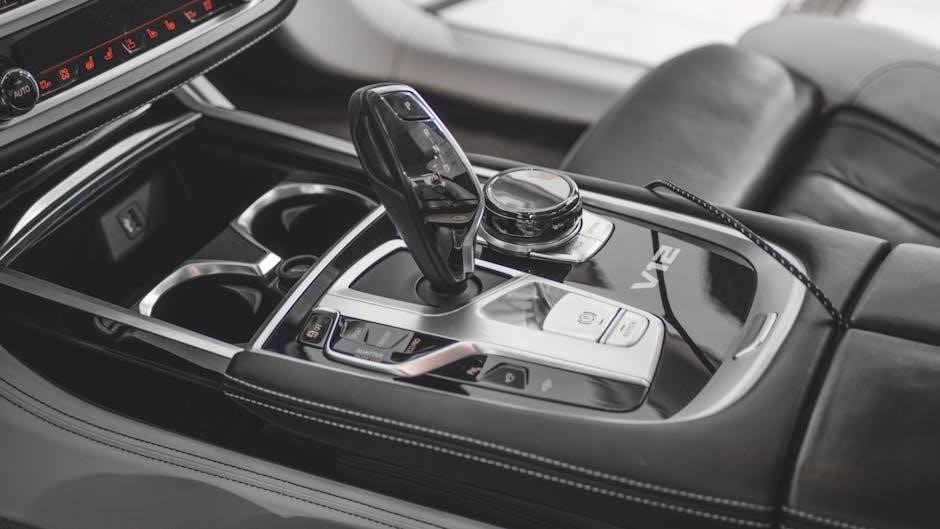Overview of Manual Shifters for Automatic Transmissions
Manual shifters in automatic transmissions offer drivers precise control over gear shifts, blending the convenience of automatics with the engagement of manual driving, enhancing performance and efficiency.
Manual shifters for automatic transmissions provide drivers with enhanced control over gear changes, offering a blend of convenience and driver engagement. Designed to complement automatic transmissions, these systems allow motorists to manually select gears, either through a traditional gearshift or paddle shifters, while retaining the ease of automatic operation. This feature is particularly beneficial in scenarios requiring precise control, such as spirited driving or navigating challenging terrain. By enabling drivers to override automatic shifting, manual shifters enhance performance, efficiency, and driving enjoyment. They are increasingly popular in modern vehicles, bridging the gap between traditional automatic and manual transmissions, and catering to drivers who value both ease and precision behind the wheel.
Importance of Understanding Manual Shifters in Modern Vehicles
Understanding manual shifters in modern vehicles is crucial for optimizing performance, efficiency, and safety. These systems, integrated into automatic transmissions, empower drivers to take control during specific driving conditions, such as uphill climbs or sharp turns, where automatic shifting may not be ideal. Familiarity with manual shifters enables drivers to make informed decisions, enhancing fuel efficiency and reducing wear on the transmission. It also allows for a more engaging driving experience, fostering a connection between the driver and the vehicle. Additionally, knowledge of manual shifters can prevent misuse, which might lead to mechanical stress or reduced longevity of the transmission. Thus, comprehension of this feature is essential for maximizing its benefits and ensuring optimal vehicle operation.

Types of Manual Shifters
Modern vehicles feature various manual shifter types, including paddle shifters, sequential gearshifts, and traditional manual modes, each offering unique control over automatic transmissions for diverse driving needs.
Paddle Shifters: Design and Functionality
Paddle shifters are small levers mounted on the steering wheel, allowing drivers to manually shift gears without removing their hands from the wheel. They are typically found in vehicles with automatic or dual-clutch transmissions. The design integrates seamlessly with the steering wheel, providing easy access for quick gear changes. Functionality-wise, paddle shifters enable drivers to override the automatic transmission’s gear selection, offering more control during spirited driving or in specific conditions like descending hills. They work by sending electronic signals to the transmission, which then executes the desired gear change. This system enhances driver engagement and performance, making it a popular feature in modern vehicles aimed at delivering a sporty driving experience.
Manual Gearshifts in Automatic Vehicles
Manual gearshifts in automatic vehicles provide drivers with the ability to manually select gears, offering enhanced control over the transmission. These systems typically feature a gearshift lever with a manual mode, allowing drivers to choose gears without the need for a clutch pedal. This setup combines the convenience of an automatic transmission with the precision of manual shifting, ideal for situations like downhill driving or towing, where maintaining a specific gear is beneficial. The functionality is straightforward: moving the lever to “M” or “Manual” mode enables gear selection, usually indicated by a display showing the current gear. This feature appeals to drivers who desire more engagement without the complexity of a fully manual transmission, making it a versatile option for various driving scenarios.
Sequential Shifters: Enhancing Driver Control
Sequential shifters are designed to enhance driver control by allowing gear changes in a specific order, typically without the need for a clutch pedal. These systems, often found in performance-oriented vehicles, provide a more direct connection to the transmission, enabling quick and precise shifts. The driver can manually select gears using a lever or paddle shifters, moving through the gears in a predetermined sequence. This feature is particularly beneficial in dynamic driving situations, such as spirited cornering or downhill descents, where maintaining optimal speed and torque is crucial. Sequential shifters strike a balance between automation and manual control, offering an engaging driving experience without the complexity of a fully manual transmission.

Functionality and Mechanics
Manual shifters in automatic transmissions function by allowing drivers to control gear changes while the system manages clutch actuation and torque distribution, optimizing performance and efficiency seamlessly.

How Manual Shifters Interface with Automatic Transmissions
Manual shifters in automatic transmissions interface through electronic controls and sensors, allowing drivers to override automatic gear selection. When a driver engages manual mode, the system bypasses the automatic shift logic, enabling direct control over gear changes. The torque converter remains engaged to maintain smooth power delivery, while the transmission’s hydraulic or electronic controls execute the driver’s commands. Sensors monitor throttle position, engine speed, and gear selection to synchronize shifts. This integration ensures seamless communication between the driver’s input and the transmission’s operation, providing a balance of driver control and automatic efficiency. The system prioritizes stability and performance, adapting to real-time driving conditions while respecting the driver’s manual inputs.
Role of the Torque Converter in Manual Shifting
The torque converter plays a crucial role in manual shifting for automatic transmissions, enabling smooth power transfer between the engine and transmission. Unlike manual transmissions, which use a clutch, the torque converter automatically engages and disengages, allowing the engine to continue running even when the vehicle is stationary. During manual shifts, the torque converter remains locked to maintain direct engine control, ensuring quick and responsive gear changes. This eliminates the need for a clutch pedal, simplifying the driver experience. The torque converter’s lock-up mechanism enhances fuel efficiency and reduces wear on transmission components, making it an essential element in the operation of manual shifters in automatic vehicles. Its seamless integration with electronic controls ensures optimal performance and driver engagement.
Electronic Controls and Sensors in Modern Systems
Modern manual shifters in automatic transmissions rely heavily on advanced electronic controls and sensors to optimize performance. These systems utilize sensors to monitor engine speed, throttle position, and vehicle acceleration, ensuring precise and timely gear shifts. Electronic controls interpret data from these sensors to adjust transmission behavior, providing smoother and more responsive shifts. Additionally, modern systems often feature paddle shifters that work in tandem with electronic controls to allow drivers to manually select gears without the need for a clutch pedal. These technologies enhance driver engagement while maintaining the convenience of an automatic transmission. The integration of electronic controls and sensors ensures seamless communication between the driver, engine, and transmission, delivering a refined and efficient driving experience.

Benefits of Manual Shifters
Manual shifters enhance driver control, offering improved fuel efficiency in specific conditions and increasing engagement, making driving more enjoyable while maintaining the convenience of automatic transmissions.
Enhanced Driver Control and Performance
Manual shifters provide drivers with increased control over gear shifts, allowing for more precise acceleration and responsiveness. By engaging manual mode, drivers can keep the engine in its optimal power band, enhancing performance during spirited driving. This feature is particularly beneficial on inclines or when needing instant power for overtaking. The ability to manually select gears ensures smoother transitions and reduces unnecessary shifting, which can improve overall driving dynamics. Additionally, manual control reduces the torque converter’s slippage, delivering more direct power to the wheels. This level of engagement not only boosts performance but also offers a more connected driving experience, making it ideal for enthusiasts seeking greater command over their vehicle’s behavior.
Improved Fuel Efficiency in Specific Driving Conditions
Manual shifters can enhance fuel efficiency in certain driving scenarios by allowing drivers to maintain optimal gear selection. For instance, in heavy traffic or uphill climbs, staying in a lower gear prevents excessive shifting, reducing fuel consumption. Similarly, when towing or carrying heavy loads, manual control ensures the transmission operates within the most efficient power range. By avoiding unnecessary automatic shifts, drivers can achieve better mileage, especially in conditions where constant acceleration and deceleration occur. This level of control not only optimizes performance but also contributes to cost savings over time, making manual shifters a practical choice for drivers seeking efficiency without sacrificing vehicle responsiveness.
Driver Engagement and Enjoyment
Manual shifters in automatic transmissions significantly enhance driver engagement and enjoyment by providing a more hands-on connection to the vehicle. Using paddle shifters or gear selectors allows drivers to take control of shifting, creating a more immersive driving experience. This interactive control fosters a sense of mastery and connection to the car, particularly during spirited driving or on winding roads. The ability to manually select gears enables drivers to tailor their driving style, whether for performance or precision, making every journey feel more dynamic and personalized. This increased involvement behind the wheel contributes to a more enjoyable and satisfying driving experience, appealing to enthusiasts who value both convenience and control.

Driving Techniques
Mastering manual shifting techniques enhances control and performance. Proper use of paddle shifters or gear selectors ensures smooth transitions, optimizing acceleration and responsiveness in various driving conditions. Consistent practice improves coordination and reflexes, helping drivers adapt to different terrains and scenarios efficiently. Understanding when to upshift or downshift is crucial for maintaining optimal engine performance and fuel efficiency. Developing a keen sense of timing and vehicle feedback allows drivers to maximize the benefits of manual shifting, making every drive more engaging and precise. Regular practice and awareness of driving conditions further refine these skills, ensuring a more enjoyable and controlled driving experience. By honing these techniques, drivers can fully utilize the potential of their automatic transmission with manual shifters, achieving a perfect balance between convenience and performance.
When to Use Manual Mode for Optimal Performance
Manual mode is ideal for driving scenarios requiring precise control, such as mountainous terrain, city traffic, or spirited driving. Engaging manual mode allows drivers to maintain optimal gear ratios, ensuring the engine operates within its torque band for better responsiveness. When ascending steep inclines, manual shifting prevents excessive gear hunting, reducing wear on the transmission. In city driving, staying in lower gears improves acceleration and maneuverability. For performance driving, manual mode enables quick upshifts and downshifts, enhancing acceleration and control. Avoiding unnecessary automatic shifts during overtaking or merging onto highways also improves efficiency. By using manual mode in these situations, drivers can optimize performance, reduce fuel consumption, and enhance overall driving satisfaction. Proper timing and understanding of gear shifts are key to maximizing these benefits.
Mastering Upshifts and Downshifts
Mastering upshifts and downshifts is crucial for optimal performance when using a manual shifter in an automatic transmission. Upshifts should occur smoothly once the engine reaches its peak power range, typically between 4,000 to 6,000 RPM, depending on the vehicle. This prevents excessive wear and maximizes acceleration. Downshifts are essential for deceleration or entering turns, as they utilize engine braking and maintain control. Proper timing ensures the vehicle remains stable and responsive. Listening to engine RPMs and feeling the car’s responsiveness helps drivers determine the ideal shift points. Consistent practice and familiarity with the vehicle’s behavior are key to mastering these techniques, enhancing both performance and driving satisfaction. Smooth transitions minimize wear on the transmission and improve overall efficiency.
Using Manual Shifters in Various Terrain and Conditions
Manual shifters in automatic transmissions are highly beneficial in diverse driving scenarios. When navigating steep inclines or declines, manual mode allows drivers to maintain control by keeping the transmission in a lower gear, preventing excessive shifting and reducing brake wear. In heavy traffic or city driving, manual shifting can enhance smooth acceleration and deceleration, minimizing jerky transitions. For towing or hauling heavy loads, manual control ensures the vehicle stays in the optimal gear for power delivery. In poor weather conditions, such as rain or snow, manual shifting can improve traction and stability by avoiding sudden gear changes. Understanding how to adapt manual shifting techniques to different terrains and conditions is essential for maximizing performance, safety, and efficiency.

Common Mistakes to Avoid
Common mistakes include improper shifting techniques, riding the clutch, and overreliance on automatic mode, which can degrade transmission performance and reduce driver control over gear changes.
Incorrect Shifting Techniques
Incorrect shifting techniques can significantly impact the performance and longevity of an automatic transmission with a manual shifter. One common mistake is shifting too aggressively, which can cause abrupt gear changes, leading to jerky acceleration and unnecessary wear on the transmission components. Another error is shifting at inappropriate speeds, such as downshifting too late or upshifting too early, which can strain the engine and transmission. Additionally, some drivers fail to adapt their shifting patterns to driving conditions, such as not using lower gears for descents or not upshifting promptly on inclines, which can reduce fuel efficiency and increase heat buildup in the transmission. Proper shifting techniques ensure smooth power delivery and extend the lifespan of the transmission.
Negative Impact of Riding the Clutch or Shifter
Riding the clutch or shifter in a vehicle equipped with a manual shifter for an automatic transmission can lead to premature wear and tear on critical components. Clutch riding, where the driver keeps the clutch partially engaged, can overheat the clutch and wear down the pressure plate and release bearing; Similarly, resting a hand on the shifter while driving can apply constant, unintended pressure, causing excessive wear on the shifter’s internal mechanisms and the transmission’s gear engagement system. This can result in costly repairs, including replacing the clutch assembly, transmission components, or even the entire transmission. Consistent awareness and proper driving habits are essential to prevent these issues and maintain the vehicle’s optimal performance and longevity.
Overreliance on Automatic Mode
Overreliance on automatic mode can diminish a driver’s ability to fully utilize the capabilities of a manual shifter in an automatic transmission. By consistently allowing the transmission to shift gears automatically, drivers may miss opportunities to optimize performance in specific driving conditions, such as uphill climbs or high-speed cornering. Additionally, relying solely on automatic mode can lead to a lack of engagement and control, potentially reducing fuel efficiency in situations where manual intervention would be beneficial. Furthermore, frequent use of automatic mode may result in the transmission adapting to driving habits that are not fuel-efficient or performance-oriented. Regular use of manual mode helps maintain driver proficiency and ensures the vehicle operates at its best in various scenarios.

Maintenance and Care
Regular maintenance ensures optimal performance of manual shifters in automatic transmissions. Check transmission fluid levels, replace filters, and inspect components for wear to prevent mechanical issues.
Transmission Fluid and Filter Maintenance
Regular transmission fluid checks are crucial for manual shifters in automatic transmissions. Low fluid levels or degraded fluid can lead to poor shifting performance and increased wear on components. It is recommended to replace the transmission fluid every 30,000 to 60,000 miles, depending on the manufacturer’s guidelines. Additionally, the transmission filter should be inspected and replaced during each fluid change to ensure clean fluid circulates through the system. Dirty or clogged filters can restrict fluid flow, causing sluggish shifting and potential damage to the transmission. Always consult the vehicle’s owner’s manual for specific maintenance intervals and procedures to maintain optimal performance and longevity of the transmission system.
Inspecting and Replacing Worn Components
Regular inspection of the manual shifter and transmission components is essential to ensure smooth operation. Over time, parts like gearsets, bearings, and seals can wear out, leading to slippage or delayed shifting. Inspect for signs of wear, such as fluid leaks, unusual noises, or inconsistent gear engagement. If components are damaged, they must be replaced promptly to prevent further damage to the transmission. Always consult the vehicle’s owner’s manual for guidance on replacement procedures and use OEM or high-quality aftermarket parts. Additionally, pay attention to warning signs like slipping gears or illuminated dashboard alerts, as these indicate potential issues. Proper maintenance ensures the longevity and performance of your manual shifter and automatic transmission system.
Regular Servicing and Checks
Regular servicing is crucial for maintaining the optimal performance of manual shifters in automatic transmissions; Schedule periodic checks with a qualified technician to inspect the transmission fluid level, condition, and filter. Clean or replace the filter as recommended to prevent contamination and ensure smooth gear transitions. Additionally, check the shifter linkage and connections for any looseness or wear, as these can affect shifting precision. Servicing should also include evaluating the torque converter and solenoids for proper function. Adhering to the manufacturer’s maintenance schedule helps prevent unexpected breakdowns and extends the life of the transmission system. Regular checks also allow early detection of potential issues, reducing costly repairs down the line.

Future Trends
Future trends include integrating manual shifters with advanced driver assistance systems and AI for predictive shifting, enhancing efficiency and driver experience in automatic transmissions.
Integration with Advanced Driver Assistance Systems
The integration of manual shifters with advanced driver assistance systems (ADAS) is revolutionizing the driving experience. These systems now incorporate predictive shifting technologies that analyze driving conditions, such as road terrain, traffic patterns, and driver behavior, to optimize gear selection. For instance, when approaching a steep incline, the system can automatically downshift to maintain torque and control. Additionally, ADAS can synchronize with features like adaptive cruise control and lane-keeping assist to enhance seamless gear transitions. This synergy between manual control and automated intelligence not only improves fuel efficiency but also reduces driver fatigue, especially in demanding driving scenarios. The future of manual shifters lies in this harmonious blend of driver input and technological oversight, creating a more intuitive and responsive driving experience.
Emerging Technologies and Their Impact on Manual Shifters
Emerging technologies are transforming manual shifters in automatic transmissions, enhancing their functionality and driver experience. Artificial intelligence and machine learning enable predictive shifting, adapting to driving styles and road conditions for optimal performance. The integration of IoT allows real-time data exchange, enabling shifters to adjust based on external factors like traffic and weather. Additionally, advancements in materials science introduce lightweight and responsive components, improving durability and tactile feedback. These innovations redefine the role of manual shifters, offering a seamless blend of autonomy and driver control, thus shaping the future of automotive technology.
Hybrid and Electric Vehicles’ Shifting Mechanisms
Hybrid and electric vehicles (EVs) are redefining shifting mechanisms, incorporating manual shifters into their automatic transmissions for enhanced efficiency. In hybrids, manual modes optimize engine and electric motor coordination, improving fuel efficiency and performance. EVs utilize manual shifters to manage regenerative braking and gear ratios, offering a more engaging drive. These mechanisms adapt traditional shifter principles to modern powertrains, allowing drivers to customize their driving experience. The integration of manual shifters in these vehicles bridges the gap between conventional and electric driving, providing a familiar interface for drivers transitioning to eco-friendly options.
Summarizing the Role of Manual Shifters
Manual shifters in automatic transmissions offer enhanced driver control, performance, and efficiency, catering to both enthusiasts and practical drivers, while adapting to future automotive innovations seamlessly.

Manual shifters in automatic transmissions seamlessly blend the convenience of automatic driving with the precision of manual control, offering drivers enhanced performance and efficiency. They allow for tailored gear selection, optimizing power delivery and fuel consumption based on driving conditions. By enabling drivers to take charge of shifts, these systems foster a more engaging and responsive driving experience. Their integration with modern technologies ensures adaptability to future automotive advancements, making them a versatile feature for both enthusiast drivers and everyday commuters. Ultimately, manual shifters play a pivotal role in balancing driver preference, performance, and practicality in contemporary vehicles.
Final Thoughts on Their Importance in Modern Driving
Manual shifters in automatic transmissions hold significant value in modern driving by empowering drivers with control and adaptability. They bridge the gap between traditional automatic convenience and the tactile engagement of manual driving, catering to both enthusiast and practical needs. By enabling precise gear selection, these systems enhance performance, efficiency, and driver satisfaction. Their integration with advanced technologies ensures compatibility with evolving automotive innovations, making them a cornerstone of future driving experiences. As vehicles advance, manual shifters remain a vital feature, offering a balanced blend of driver preference, technological advancement, and real-world applicability. Their enduring relevance underscores their importance in shaping the future of automotive control and driver engagement.
